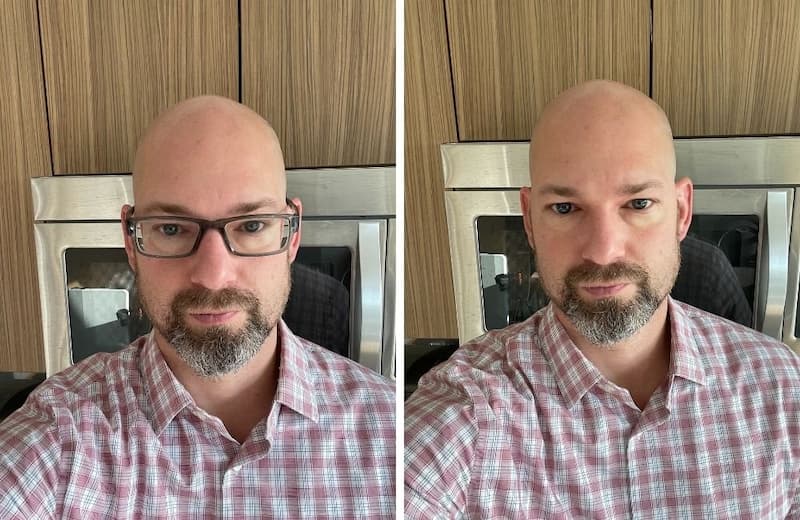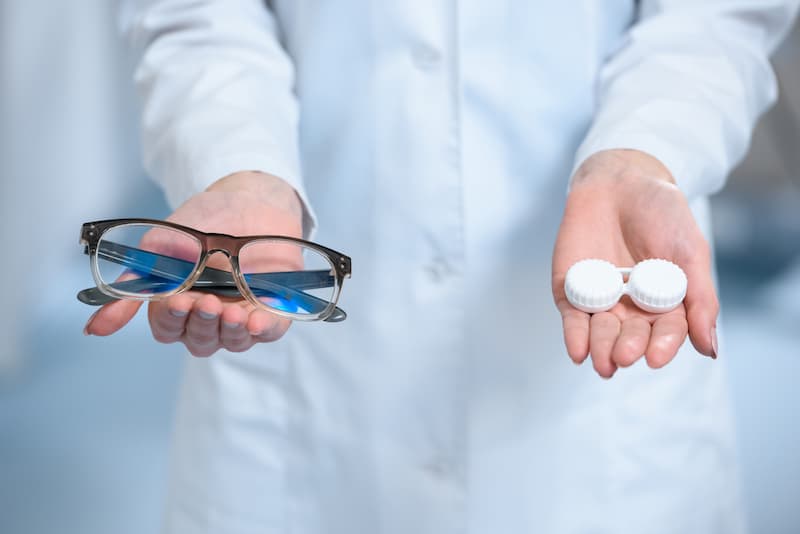Can You Wear Contacts And Glasses? See Answer

To start with, can you wear contacts and glasses?
Yes. It’s possible to wear contacts and glasses.
Numerous vision problems can be resolved by doing this, which is why many people do it. While the contacts help with farsightedness, the glasses may aid in reading. Dealing with both contacts and glasses at once can be annoying and expensive.
We’ll discuss the potential reasons for wearing both as well as your options for future assistance.
To learn more, keep reading.
Why You Might Be Wearing Glasses And Contacts?
Wearing contact lenses and glasses simultaneously may seem counterproductive. But this is a question we get asked a lot, and it happens more frequently than you might think.
It’s a simple solution that can address many eye-related issues that a person might experience. For instance, if you wear contact lenses to improve your distance vision, you might also have reading glasses (or vice versa).
“Presbyopia is a condition that most frequently requires the use of both glasses and lenses.”
Even if a person already wears contact lenses for long-distance vision correction, they still require reading glasses as their eyes get older and less flexible. This is an aging-related condition that typically manifests around the age of 45.
There are some advantages to using reading glasses rather than contact lenses, not the least of which is the elimination of the need to carry around two pairs of glasses.
But the price of glasses and lenses quickly mounts, and having to pay for them every day can be annoying. Because of this, a lot of people look for long-term fixes that will do away with the need for glasses and lenses.
How Do I Wear Contacts With Glasses?
Our eyesight deteriorates as we age—and we all do, despite our best efforts to stop it.
Between the ages of 40 and 50, our ability to focus on close-up objects begins to deteriorate.
Why?
It is because of what happens to the lens of your eye, either technically or medically, that your vision begins to deteriorate for close-up vision.
The retina, a special type of light-sensitive tissue at the back of your eye, receives an image from light through a natural lens called the crystalline lens. To alter its shape and the focus on your eye, this lens flexes in and out. Your eyesight suffers when it begins to lose its elastic ability and is unable to flex as well as it once could because it accounts for one-third of the optical power in your eye.
Close-up vision, which includes the capacity to read words, is typically made more difficult. As a result, reading glasses become necessary.
You have two options if you currently wear contact lenses to treat your distance vision issues.
Dropping the contact lenses will require you to take on the challenge of donning two unique pairs of glasses OR donning both glasses and contact lenses at the same time. See more about Can You Wear Contacts After Lasik?
The Trouble Of Choosing Glasses Or Contact Lenses
It can be challenging to understand why you need both glasses and contact lenses.
When opting for contact lenses to correct their vision, many people find it difficult to consider wearing glasses.
When that happens, they might ask themselves, “How can I wear contacts with glasses? And why would I?’
It makes sense to wear contact lenses with your glasses if they are only being worn to correct your near vision.
Not only will it be more convenient for you to not have to carry around multiple pairs of glasses, but you can keep your glasses on solely for reading.
This almost always occurs indoors, such as when reading at home or sitting at a desk for work.
When you exercise or play a sport, you won’t need to wear glasses, and the same is true for outdoor gatherings.
When you need to focus on things up close, a pair of reading glasses can help, while contact lenses give you the freedom of all-around vision.
The stigma associated with needing glasses to correct your vision isn’t that it’s a boring or even unsightly process. There are some amazing new eyeglass collections available right now that enhance your appearance with style and personality.

How To Put Colored Contacts In While Wearing Glasses?
Instead of being difficult, selecting your eyewear style can be enjoyable.
It all comes down to a few key things;
- What kind of frame best complements your face?
- What shade of frame best reflects your personality?
- What unique feature would you like to see in your glasses?
Once you have provided your responses to those questions, there are three things to keep in mind.
- Remember to bring your glasses with you
- Have more than one pair (because you may misplace, forget or lose your glasses)
- Don’t worry about the colour of your glasses clashing with the colour of your eyes
You have a wide range of options when it comes to wearing glasses, which is fantastic to know.
I should probably ask how to wear contacts with glasses than that question. Why hadn’t I ever done this before? is a question you’ll likely ask.
You can wear any style and color of glasses you like if you wear colored contact lenses.
To make your eyes really pop, you could even try matching the color of your eyes to the color of your eyeglasses or creating a unique contrast.
That is the whole appeal of colored contacts—fun, variety, and a new appearance whenever you want it.
Switching From Glasses To Contacts
The transition to contacts after years of wearing glasses can be difficult. Learning to insert the contacts presents a challenge for many people, particularly kids and teenagers, right away. To ensure that we can provide plenty of assistance during this initial stage, we advise putting in your contacts while you are still in our office.
We also want you to remember a few other things, the first of which is to always wash your hands before removing or inserting your contacts. Other tips:
Ease Into Contacts
Especially at first, avoid wearing your contacts too frequently. For the first week, try wearing them for a few hours each day to get used to them.
Know Your Limits
Never wear your contacts for longer than recommended. Only wear daily or weekly clothes you buy for this amount of time.
Eyes On The Job
Remember that wearing contact lenses can make your eyes uncomfortable. In fact, the Canadian Center for Occupational Health and Safety reports that some workplaces have policies against wearing contacts. Make sure you are aware of any potential effects wearing contacts may have on your eyes.
Seasons In Time
When wearing contacts, especially in the spring and summer, be prepared for increased difficulty. Allergies caused by pollen and dust may irritate your eyes.
Switching From Contacts To Glasses
If you’ve worn contacts for a long time and are ready to switch back to glasses, you should transition slowly, just as you did when you first started wearing contacts. These tips can help:
Different Perspective
Allow yourself time to get used to how the world appears differently when you have on glasses. Naturally, contacts fully enclose the eye, whereas glasses rest on the bridge of the nose. The lenses won’t completely cover the peripheral vision region of your field of vision, which results in some distortion.
Bigger, Brighter
When you switch, things might appear a little bit larger, brighter, or sharper focused. If this is too much, try wearing your glasses for a few hours each day, preferably at night when it won’t be as bright.
No Scratching!
Never use anything other than a cloth made specifically to clean glasses to wipe them down. You risk leaving small scratches in the lenses if you rub them against your shirt or a napkin.
Blue Light Special
Especially if you spend all day staring at a computer, get glasses with built-in blue light filters. Your daily tasks may be simpler as a result, and you won’t feel as worn out after a long day of typing.
Frame Your Narrative
Invest in eyewear that complements your face and your prescription. Large lenses intended to correct severe vision issues don’t look good with some frame styles. Additionally, check to see that the eyeglasses are comfortable on your face; headaches can result from frames that pinch behind your ears or on your nose.
Never Wear Glasses Or Lenses Again
For patients with a range of eye issues, laser eye surgery offers a long-term solution. Given that this may be your first time thinking about laser eye surgery, we’ll go over some fundamentals and dispel some myths.
- How Does Surgery Actually Work?
- How painful is laser eye surgery?
- How soon will things return to normal for me?
- Is it Expensive?
What Exactly Takes Place During Lasik Surgery?
Depending on the vision problems you have, there are different procedures available. The ideal course of action will be suggested by your surgeon. A tiny tool called a speculum is used to gently keep your eyelids apart once the procedure starts.
A femtosecond laser is used to make a tiny flap on the cornea during LASIK surgery, for instance. Although it might sound a little scary, that part of the procedure only lasts 20–25 seconds. Each eye only needs to undergo the procedure once, and it only takes a few minutes.
Consider Bifocal Contact Lenses
Bifocal contact lenses are a particular kind of multifocal contact lens that offers two different powers, improving both distance and near vision. They function similarly to progressive glasses and are a type of multifocal contact lens. Bifocal contacts, like glasses, are most frequently used to correct for distance and reading. Additionally, multifocal lenses enhance vision in various visual fields and may even correct vision at intermediate distances while facilitating a more seamless transition between them.
It is simple to order contacts online because the biggest brands produce both multifocal and bifocal contact lenses and offer them in daily-, weekly-, and monthly-disposable varieties. Choosing your lenses, entering your insurance information, and paying the out-of-pocket cost will allow you to use your insurance when ordering contacts online.
Conclusion
In general, glasses will be worn on top of contact lenses as needed to correct vision for close-up work and throughout the day to correct vision for longer distances. The wearer no longer needs to carry two pairs of glasses around with them for every situation thanks to this system.
If this is the case, it is crucial to visit an optometrist before purchasing reading glasses because it indicates that the eyes have changed and that the prescription may have also. It’s also a good idea to make a personal appointment so you can discuss how frequently you will need to use this solution and the best way to handle juggling the two sets.
Regarding your reading, I thank you.